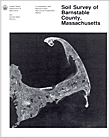The following is a map unit description from the "Soil Survey of Barnstable County, Massachusetts (Fletcher, 1993)" for more information contact the USDA-NRCS http://nesoil.com/barnstable or

AmA-Amostown sandy loam, 0 to 5 percent slopes.
This very deep, nearly level and gently sloping, moderately well drained soil is in depressions and swales in areas of glacial lake deposits. It makes up approximately 0.1 percent (285 acres) of the survey area. It is mapped mainly in the Plymouth-Eastchop-Carver-Boxford general soil map unit. Areas are irregular in shape and range from 5 to 60 acres in size.
Typically, the surface is covered with an organic layer. This layer is about 1 inch of loose, undecomposed pine needles, leaves, and twigs and 1 inch of partly decomposed and well decomposed organic material. The surface layer is friable sandy loam about 7 inches thick. The upper 2 inches is very dark grayish brown, and the lower 5 inches is dark brown. The subsoil is friable sandy loam about 26 inches thick. The upper 6 inches is yellowish brown, the next 14 inches is light olive brown, and the lower 6 inches is light olive brown and mottled. The substratum to a depth of 65 inches or more is stratified light olive brown, yellowish brown, and grayish brown, mottled very fine sandy loam and silt loam. It is friable or firm.
Included with this soil in mapping are small areas of Belgrade, Boxford, Deerfield, and Walpole soils. Also included are many areas where the soil is underlain by sandy or gravelly material below a depth of 65 inches. Included soils make up about 30 percent of this unit.
Permeability is moderately rapid in the subsoil of the Amostown soil and slow or moderately slow in the substratum. Available water capacity is moderate. The seasonal high water table is at a depth of 1.5 to 3.0 feet in late fall, in winter and early spring, and after periods of heavy precipitation.
Most areas are used as woodland. Some areas have been developed for homesites, and a few areas are cultivated.
This soil is well suited to cultivated crops. Good tilth can be easily maintained. The seasonal high water table commonly keeps the soil wet in early spring and delays farming activities. A drainage system is needed for maximum crop yields and the efficient use of machinery. In the gently sloping areas, farming on the contour or across the slope, including grasses and legumes in the crop rotation, establishing diversions, applying a system of conservation tillage, and growing cover crops reduce the hazard of erosion. Growing cover crops and including grasses and legumes in the cropping system improve tilth. Mixing crop residue and manure into the surface layer also improves tilth.
This soil is well suited to hay and pasture. The main management objective is the prevention of overgrazing, which reduces the hardiness and density of desirable plants and exposes the soil to erosion. Proper stocking rates, timely grazing, and restricted use during wet periods help to maintain plant density and minimize surface compaction.
This soil is well suited to woodland. No major hazards or limitations restrict woodland management. Removal or control of competing vegetation helps to obtain the best growth of newly established seedlings. The most common trees are eastern white pine, red maple, white oak, and scarlet oak.
The seasonal high water table is a limitation if this soil is used as a site for dwellings with or without basements or as a site for septic tank absorption fields. The slow or moderately slow permeability in the substratum also is a limitation on sites for septic tank absorption fields. Additions of fill or a regional drainage system helps to overcome the wetness. Enlarging the absorption field helps to overcome the restricted permeability. In areas where the soil is underlain by sandy and gravelly material below a depth of 60 inches, excavations that extend to this material generally can overcome the restricted permeability.